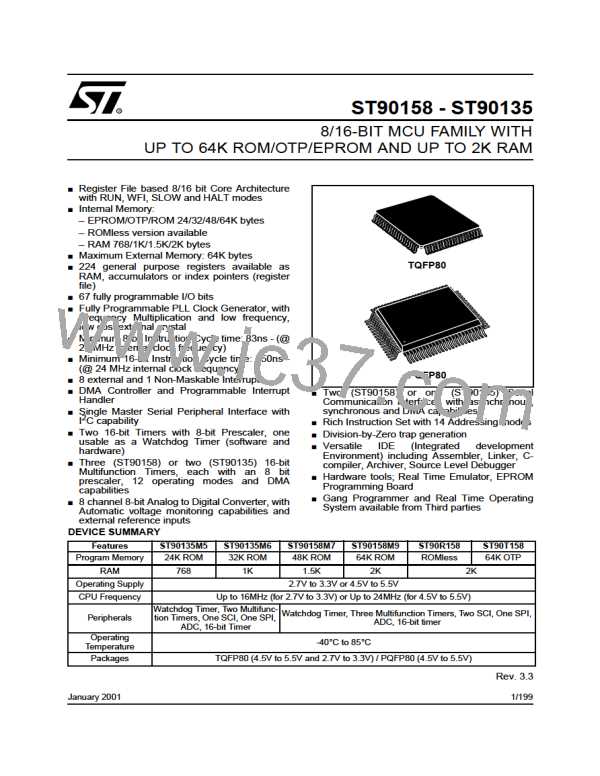ST90158 - RESET AND CLOCK CONTROL UNIT (RCCU)
6 RESET AND CLOCK CONTROL UNIT (RCCU)
6.1 INTRODUCTION
ble of multiplying the clock frequency by a factor of
6, 8, 10 or 14; the multiplied clock is then divided
by a programmable divider, by a factor of 1 to 7. By
this means, the ST9 can operate with cheaper,
medium frequency (3-5 MHz) crystals, while still
providing a high frequency internal clock for maxi-
mum system performance; the range of available
multiplication and division factors allow a great
number of operating clock frequencies to be de-
rived from a single crystal frequency.
The Reset and Clock Control Unit (RCCU) com-
prises two distinct sections:
– the Clock Control Unit, which generates and
manages the internal clock signals.
– the Reset/Stop Manager, which detects and
flags Hardware, Software and Watchdog gener-
ated resets.
On ST9 devices where the external Stop pin is
available, this circuit also detects and manages
the externally triggered Stop mode, during which
all oscillators are frozen in order to achieve the
lowest possible power consumption.
For low power operation, especially in Wait for In-
terrupt mode, the Clock Multiplier unit may be
turned off, whereupon the output clock signal may
be programmed as CLOCK2 divided by 16. For
further power reduction, a low frequency external
clock connected to the CK_AF pin may be select-
ed, whereupon the crystal controlled main oscilla-
tor may be turned off.
6.2 CLOCK CONTROL UNIT
The Clock Control Unit generates the internal
clocks for the CPU core (CPUCLK) and for the on-
chip peripherals (INTCLK). The Clock Control Unit
may be driven by an external crystal circuit, con-
nected to the OSCIN and OSCOUT pins, or by an
external pulse generator, connected to OSCIN
(see Figure 37 and Figure 39).
The internal system clock, INTCLK, is routed to all
on-chip peripherals, as well as to the programma-
ble Clock Prescaler Unit which generates the clock
for the CPU core (CPUCLK).
The Clock Prescaler is programmable and can
slow the CPU clock by a factor of up to 8, allowing
the programmer to reduce CPU processing speed,
and thus power consumption, while maintaining a
high speed clock to the peripherals. This is partic-
ularly useful when little actual processing is being
done by the CPU and the peripherals are doing
most of the work.
6.2.1 Clock Control Unit Overview
As shown in Figure 31, a programmable divider
can divide the CLOCK1 input clock signal by two.
The divide-by-two is recommended in order to en-
sure a 50% duty cycle signal driving the PLL mul-
tiplier circuit. The resulting signal, CLOCK2, is the
reference input clock to the programmable Phase
Locked Loop frequency multiplier, which is capa-
Figure 31. Clock Control Unit Simplified Block Diagram
CLOCK2/128
to
Standard Timer
1/16
1/8
CPUCLK
to
CPU Core
CPU Clock
Prescaler
PLL
Clock Multiplier
Quartz
oscillator
/Divider Unit
1/2
CLOCK2
CLOCK1
CK_AF
INTCLK
to
CK_AF
source
Peripherals
67/199
9

 ETC [ ETC ]
ETC [ ETC ]